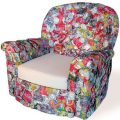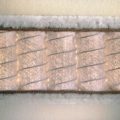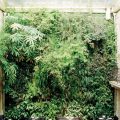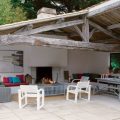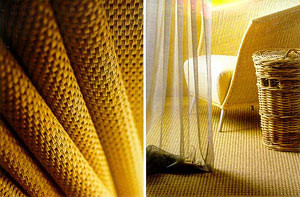 Floor matThe history of the mat goes back to the depthscenturies. Reed and lotus mats have been found in Egyptian tombs in the Valley of the Kings. In Ancient Greece and Rome, the floors of houses were decorated with woven carpets or mats. In Japan, woven floor mats - tatami - are still an indispensable element of the interior. They were very fashionable at the turn of the 19th and 20th centuries. In the West, fashion returned in the 90s of the 20th century, with the spread of eco-design. Mats could not have come at a better time: in addition to being made from the purest natural materials, they are also hypoallergenic and are also beneficial for health due to their light massage effect on the feet. And if the weave is thick, they also provide good sound insulation. Materials for making mats The main materials for making mats are traditional and have not changed since ancient times. Fibers were obtained from the leaves or trunks of plants by pulling or separating from the pulp. People wove them together, dried them and made something like a thread or thin rope, then simply intertwined them and got a strong and beautiful floor covering. The most common plant materials for making mats are reed, jute, sisal, coir. Rice, flax, hemp, cotton are used less often. Reed It grows on marshy soil and on the banks of reservoirs. There are many types of reeds from which mats can be made - different countries have their own varieties of this plant, which are traditionally used to create floor or wall coverings. The height of the reed does not exceed 1.5 meters, so craftsmen have to connect the stems of several plants to make a long rope. Jute This is a genus of shrubs, subshrubs and herbs of the linden family - there are about 100 species and are found in the tropics of Asia, Africa and America. Jute mats are particularly durable and have strong stems, so they are often used for technical purposes or in high traffic areas, such as offices or doormats. SisalThis is a fiber from the leaves of the American agave, which grows mainly in Mexico, Kenya, and Tanzania. The length and strength of the resulting thread depends on the length and thickness of the fiber. The best mats are those woven from long leaves. Coir
Floor matThe history of the mat goes back to the depthscenturies. Reed and lotus mats have been found in Egyptian tombs in the Valley of the Kings. In Ancient Greece and Rome, the floors of houses were decorated with woven carpets or mats. In Japan, woven floor mats - tatami - are still an indispensable element of the interior. They were very fashionable at the turn of the 19th and 20th centuries. In the West, fashion returned in the 90s of the 20th century, with the spread of eco-design. Mats could not have come at a better time: in addition to being made from the purest natural materials, they are also hypoallergenic and are also beneficial for health due to their light massage effect on the feet. And if the weave is thick, they also provide good sound insulation. Materials for making mats The main materials for making mats are traditional and have not changed since ancient times. Fibers were obtained from the leaves or trunks of plants by pulling or separating from the pulp. People wove them together, dried them and made something like a thread or thin rope, then simply intertwined them and got a strong and beautiful floor covering. The most common plant materials for making mats are reed, jute, sisal, coir. Rice, flax, hemp, cotton are used less often. Reed It grows on marshy soil and on the banks of reservoirs. There are many types of reeds from which mats can be made - different countries have their own varieties of this plant, which are traditionally used to create floor or wall coverings. The height of the reed does not exceed 1.5 meters, so craftsmen have to connect the stems of several plants to make a long rope. Jute This is a genus of shrubs, subshrubs and herbs of the linden family - there are about 100 species and are found in the tropics of Asia, Africa and America. Jute mats are particularly durable and have strong stems, so they are often used for technical purposes or in high traffic areas, such as offices or doormats. SisalThis is a fiber from the leaves of the American agave, which grows mainly in Mexico, Kenya, and Tanzania. The length and strength of the resulting thread depends on the length and thickness of the fiber. The best mats are those woven from long leaves. Coir This fiber from the nut of the coconutpalm trees. Do not confuse with copra (this is the dried palm fruit used to make coconut oil, margarine and soap). The best coir is obtained from unripe nuts, which are soaked in seawater to give elasticity to the fiber, and then combed out. The longest fibers (25-30 cm) are used to make a coir yarn, on which mats are made, as well as mats, ropes and ropes that do not get wet and not sinking in water, and fishing nets. The short and tangled fiber of ripe nuts goes on the padding of the mattresses. Coir is produced mainly in India and on the island of Sri Lanka (Ceylon). Rice straw rice is thinner and softer than its fellows. The Chinese and Japanese, immediately after they harvested the rice, weave a mat from the stalks and then dry it in the sun. The mat in this case gains flexibility, a specific pleasant aroma and strength. In firms focused on the Western market, the stems are dried, then mats are tied. At the same time, the strength of the material is not lost at all, but the smell disappears, besides, the fibers become a little rougher than those used fresh. Cotton Nomads were the first to use it; it is a very cheap and easy-to-manufacture material, the threads from which were obtained very durable, suitable not only for clothing, but also for the manufacture of interior items. In the production of carpets and mats in our time it is used as a mesh base, which protects them from deformation. Paper It is made from cotton or rice, subjected to special processing and is not afraid of water, unlike ordinary paper. Making mats completely out of paper is expensive and time-consuming, so the price for such a handmade product can go up to $ 5,000. thirty%). In addition to Japan, where natural paper mats are still being made, it is traditionally considered to be a paper mat if it contains at least 30% of paper fiber. LenS from ordinary flax produce fabrics that are not new to Russia. But when several fibers are joined together, a thin and strong material is obtained that is suitable for creating the finest rugs. They are very beautiful, but, unfortunately, are short-lived, therefore they are suitable only for walls. And then there is Indonesian flax, more like a cactus, from the leaves of which very long and thick fibers are drawn. The inhabitants of Indonesia weave mats out of them, which they then sell to tourists. In stores such are extremely rare. KonoplyaThis plant can be useful. The most popular hemp threads are used in countries such as Holland, Jamaica, USA, Cuba, Canada. This technical culture is easy to grow and inexpensive to process, which allows you to get relatively cheap raw materials. In Russia, hemp rugs can only be found in specialized esoteric stores. They are produced not in Western countries, but in India and Sri Lanka, therefore they do not differ in special quality. Algae Not everyone knows that mats are also made from many seaweed. Long algae fibers dry, twist and weave thin and very flexible mats out of them. Such products are usually not painted, have a natural green, brown or beige color. They have a faint smell of sea salt, which can be used to determine whether it is a fake or not. Produced in the countries of Southeast Asia: in Thailand, Japan, Indonesia, on the islands of Bali and Jamaica.
This fiber from the nut of the coconutpalm trees. Do not confuse with copra (this is the dried palm fruit used to make coconut oil, margarine and soap). The best coir is obtained from unripe nuts, which are soaked in seawater to give elasticity to the fiber, and then combed out. The longest fibers (25-30 cm) are used to make a coir yarn, on which mats are made, as well as mats, ropes and ropes that do not get wet and not sinking in water, and fishing nets. The short and tangled fiber of ripe nuts goes on the padding of the mattresses. Coir is produced mainly in India and on the island of Sri Lanka (Ceylon). Rice straw rice is thinner and softer than its fellows. The Chinese and Japanese, immediately after they harvested the rice, weave a mat from the stalks and then dry it in the sun. The mat in this case gains flexibility, a specific pleasant aroma and strength. In firms focused on the Western market, the stems are dried, then mats are tied. At the same time, the strength of the material is not lost at all, but the smell disappears, besides, the fibers become a little rougher than those used fresh. Cotton Nomads were the first to use it; it is a very cheap and easy-to-manufacture material, the threads from which were obtained very durable, suitable not only for clothing, but also for the manufacture of interior items. In the production of carpets and mats in our time it is used as a mesh base, which protects them from deformation. Paper It is made from cotton or rice, subjected to special processing and is not afraid of water, unlike ordinary paper. Making mats completely out of paper is expensive and time-consuming, so the price for such a handmade product can go up to $ 5,000. thirty%). In addition to Japan, where natural paper mats are still being made, it is traditionally considered to be a paper mat if it contains at least 30% of paper fiber. LenS from ordinary flax produce fabrics that are not new to Russia. But when several fibers are joined together, a thin and strong material is obtained that is suitable for creating the finest rugs. They are very beautiful, but, unfortunately, are short-lived, therefore they are suitable only for walls. And then there is Indonesian flax, more like a cactus, from the leaves of which very long and thick fibers are drawn. The inhabitants of Indonesia weave mats out of them, which they then sell to tourists. In stores such are extremely rare. KonoplyaThis plant can be useful. The most popular hemp threads are used in countries such as Holland, Jamaica, USA, Cuba, Canada. This technical culture is easy to grow and inexpensive to process, which allows you to get relatively cheap raw materials. In Russia, hemp rugs can only be found in specialized esoteric stores. They are produced not in Western countries, but in India and Sri Lanka, therefore they do not differ in special quality. Algae Not everyone knows that mats are also made from many seaweed. Long algae fibers dry, twist and weave thin and very flexible mats out of them. Such products are usually not painted, have a natural green, brown or beige color. They have a faint smell of sea salt, which can be used to determine whether it is a fake or not. Produced in the countries of Southeast Asia: in Thailand, Japan, Indonesia, on the islands of Bali and Jamaica.

Making Money with Desserts: Success Stories
Evgeniya Polischuk (Fedutinova) instagram:@evgeniyafedutinovavk.com/janeshomebaking– It all started with baking for family and friends. Gradually, I started posting photos of my baked goods on Instagram – and orders started coming in. I made my first custom-made cake on October 13, 2014, and a little earlier I started making macaroons and cupcakes. You could say that the business “found me”, I am very […]

Soups are cold recipes with photos
Cold cucumber soup with yogurt and lemonsorbet from the chef of the restaurant La Taverna Alexander Zhurkin Photo: Getty Images Ingredients: Plain yoghurt – 125 g Cucumber – 150 g Lemon/lime sorbet – 50 g Cocktail shrimp – 24 g Fresh ginger juice – 1 g Lime juice – 5 g Fresh orange juice – 5 g Parsley – 1 g Pink pepper – 1 g Watercress – […]

barbeque kebab
Pork tenderloin in glaze Photo:Dmitry Bayrak/dbstudioPreparation time: 20 minutes + marinating time.Calories: 454 kcal per serving.For 4 servings: 4 pork tenderloins (approximately 300 g each), 1 onion, 2 cloves of garlic, 1 tsp. lemon zest, 1 tsp. lemon juice, a pinch of ground cumin, coriander and turmeric, 1 tbsp. vegetable […]

Pierre Duacan: dietary recipes: Ducane diet
Beetroot soup Photo:Season’S, Luxury Hotels RepresentationYou will need:· Boiled beetroot – 60 g· Fresh cucumbers – 20 g· Red radish – 20 g· Green onions – 10 g· Egg – 1 pc.· Drinking mineral water – 200 g· Salt – 1 gPreparation:· Boil the egg and beetroot.· Grate the cucumbers, radish and part of the beetroot. Put everything […]
